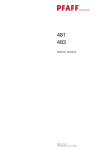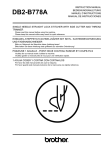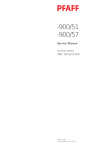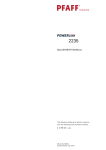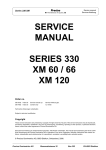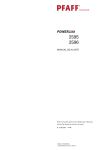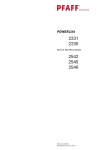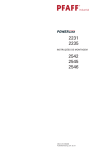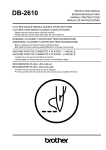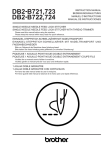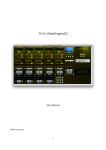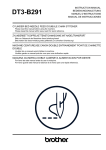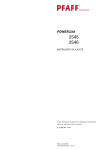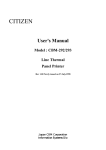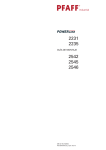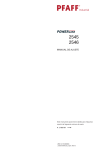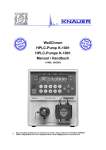Download ADJUSTMENT MANUAL
Transcript
1245 1246 ADJUSTMENT MANUAL This adjustment manual applies to machines from the following serial numbers onwards: # 6 500 124 296-12-19 200/002 Justieranleitung engl. 01.12 The reprinting, copying or translation of PFAFF Instruction Manuals, whether in whole or in part, is only permitted with our previous authorization and with written reference to the source. PFAFF Industriesysteme und Maschinen AG Hans-Geiger-Str. 12 - IG Nord D-67661 Kaiserslautern Index Contents ..................................................................................Page 1 Adjustment ........................................................................................................................... 4 1.01 Tools, gauges and other accessories for adjusting ............................................................... 4 1.02 Abbreviations ......................................................................................................................... 4 1.03 Explanation of the symbols .................................................................................................... 4 1.04 Adjusting the basic machine .................................................................................................. 5 1.04.01 Positioning the feed dog across the direction of sewing ....................................................... 5 1.04.02 Positioning the feed dog in the direction of sewing .............................................................. 6 1.04.03 Height of the bottom feed-dog ............................................................................................. 7 1.04.04 Pre-adjusting the needle height ............................................................................................. 8 1.04.05 Centering the needle in the needle hole ................................................................................ 9 1.04.06 Lifting motion of the bottom feed-dog. ................................................................................ 10 1.04.07 Driving motion of the bottom and top feeds ........................................................................ 11 1.04.08 Hook-to-needle clearance, needle rise, needle height and needle guard ............................ 12 1.04.09 Top-feed stroke .................................................................................................................... 14 1.04.10 Lifting motion of the top feed ............................................................................................. 15 1.04.11 Bobbin-case opener ............................................................................................................. 16 1.04.12 Safety clutch ........................................................................................................................ 17 1.04.13 Needle thread tension release ............................................................................................. 18 1.04.14 Bobbin winder ...................................................................................................................... 19 1.04.15 Presser-foot pressure ........................................................................................................... 20 3 Adjustment 1 Adjustment Please observe all notes from Chapter 1 Safety of the instruction manual! In particular care must be taken to see that all protective devices are refitted properly after adjustment, see Chapter 1.06 Danger warnings of the instruction manual! If not otherwise stated, the machine must be disconnected from the electrical power supply. Danger of injury due to unintentional starting of the machine! The illustrations in this section show the PFAFF 1245 single-needle machine. For the PFAFF 1246 two-needle machine, various adjustments must be made twice, i.e. to the left- and right-hand sewing hooks. This will be pointed out in the respective sections, whereby it is often possible to apply the mirror image of the illustrations. Notes on adjustment All following adjustments are based on a fully assembled machine and may only be carried out by expert staff trained for this purpose. Machine covers, which have to be removed and replaced to carry out checks and adjustments, are not mentioned in the text. The order of the following chapters corresponds to the most logical work sequence for machines which have to be completely adjusted. If only specific individual work steps are carried out, both the preceding and following chapters must be observed. Screws, nuts indicated in brackets ( ) are fastenings for machine parts, which must be loosened before adjustment and tightened again afterwards. 1.01 Tools, gauges and other accessories for adjusting ● Screwdrivers withi blade widths from 2 to 10 mm ● Spanners (wrenches) in sizes from 7 to 14 mm ● Allen keys from 1.5 to 6 mm ● Metal rule (part No. 08-880 218-00) ● Needle-rise gauge (part No. 61-111 600-01) ● Gauge, (top feed stroke 7 mm) (Part No. 61-111 633-61) ● Screw clamp (part No. 61-111 600-35) 1.02 Abbreviations t.d.c. = top dead centre b.d.c. = bottom dead centre 1.03 Explanation of the symbols In this adjustment manual, symbols emphasize operations to be carried out or important information. The symbols used have the following meaning: Note, information Service, repair, adjustment, maintenance (work to be carried out by qualified staff only) 4 Adjustment 1.04 Adjusting the basic machine 1.04.01 Positioning the feed dog across the direction of sewing Requirement The bottom feed dog must be the same distance from the left and right side of the needle-plate cutout. 4 3 4 2 1 1 Fig. 1 - 01 ● Loosen screws 1 and 2. ● Laterally align rock shaft 3 in accordance with the requirement. ● Now tighten screws 1. The flat sides of pins 4 must be opposite the flat sides of screws 1 and rock shaft 3 must exhibit neither play nor stiffness. ● Screws 2 remain loose for the following adjustments.. 5 Adjustment 1.04.02 Positioning the feed dog in the direction of sewing Requirement With the longest stitch set, the bottom feed dog must have the same clearance the front and the back with respect to the needle-plate cutout when feeding both forwards and backwards. 1 2 Fig. 1 - 02 ● Set the longest stitch. ● Adjust rock shaft 1 in accordance with the requirement and tighten screws 2. 6 Adjustment 1.04.03 Height of the bottom feed-dog Requirement With the stitch length set at "0", the bottom feed dog must protrude over the needle plate as high as the teeth when at TDC. 1 2 Fig. 1 - 03 ● Set stitch length "0". ● Bring the bottom feed dog to its TDC by turning the handwheel. ● Adjust feed dog carrier 1 (screws 2) in accordance with the requirement. If required, the feed dog height can be reduced a little on machines without a bottom feed lifting phase (without P). 7 Adjustment 1.04.04 Pre-adjusting the needle height Requirement With the needle bar at BDC, the distance between the needle bar and the needle plate must be 15 mm. 2 1 Fig. 1 - 04 ● Move needle bar 1 (screw 2) in accordance with the requirement without moving it laterally. 8 Adjustment 1.04.05 Centering the needle in the needle hole Requirement With the stitch length set at "0", the needle must enter the needle hole exactly in the middle. 4 3 7 6 5 8 9 1 2 Fig. 1 - 05 ● Unscrew vibrating presser 1 and presser foot 2. ● Set stitch length "0" and bring the needle bar to its TDC. ● Insert a new needle. Loosen screws 3, 4, 5 and 6. ● Position the needle directly over the bottom feed dog by turning the handwheel. ● Move needle bar frame 7 in accordance with the requirement. ● Tighten screws 3, 4 and 5. ● Position stop 8 so that it is touching needle bar frame 7 and tighten screw 6. The movement of needle bar frame 7 in guide 9 and of the top feed drive bars must not be stiff. 9 Adjustment 1.04.06 Lifting motion of the bottom feed-dog (This adjustment does not apply for machines without a bottom feed lifting phase (without P). Requirement 1. With the needle bar at its BDC, the bottom feed dog must be at its TDC. 2. With the longest stitch set, the bottom feed dog must reach the top surface of the needle plate at the same time as the needle point when the handwheel is turned. 1 2 Fig. 1 - 06 ● Bring the needle bar to its BDC. ● Turn feed lifting eccentric 1 (screws 2) in accordance with requirement 1. ● In this position, tighten the accessible screw 2 until feed lifting eccentric 1 can be turned with difficulty. ● Turn feed lifting eccentric 1 a little further in accordance with requirement 2. ● Tighten both screws 2. 10 Adjustment 1.04.07 Driving motion of the bottom and top feeds Requirement With the longest stitch length set and the needle bar at its BDC, the top and bottom feeds should not move when the reverse-feed lever is activated.. 1 2 Fig. 1 - 07 ● Set the longest stitch. ● Loosen screws 1 just far enough so that the feed driving eccentric 2 can be turned on the shaft with difficulty. ● Bring the needle bar to its BDC. ● Turn the feed driving eccentric 2 so that its eccentricity is facing downwards. ● Now turn it a little in the direction of rotation in accordance with the requirement. ● In this position, tighten screws 1. ● Carry out a check in accordance with the requirement. 11 Adjustment 1.04.08 Hook-to-needle clearance, needle rise, needle height and needle guard (On Model 1246 make these adjustments on both sewing hooks.) Requirement When the stitch length is set at "3" and with the needle rise position set (see table): 1. the hook point must be at "needle centre" with a hook-to-needle clearance of 0.05 to 0.1 mm; 2. the top of the needle eye must be 0.8 - 1,0 mm below the hook point; 3. and needle guard 5 must touch the needle just lightly.. Needle rise position: Model C: 2,0 mm after b.d.c. off the needle bar 1 1 3 2 2 3 3 2 1 1 Fig. 1 - 08 ● Set stitch length "3" and loosen screws 1, 2 and 3. ● Bring the needle to its BDC and slide the appropriate feeler gauge under the needle bar bearing. ● Position the adjustable clamp against the feeler gauge and screw it tight. ● Remove the feeler gauge and turn the balance wheel in its direction of rotation until the adjustable clamp is touching the needle bar bearing. 12 Adjustment 1 4 1 3 2 7 7 6 2 6 3 3 2 4 1 1 5 Fig. 1 - 08 ● Move hook bearing 4 in accordance with requirement 1. ● Tighten screws 1. ● Position the hook point at the needle centre, taking care to ensure that the needle is not deflected by needle guard 5. ● While ensuring that bevel gear 6 is not too close, and that the hook does not have too much play, tighten screws 2. ● Position retaining collar 7 so that it rests on bevel gear 6 and tighten screws 3. ● Adjust the needle height in accordance with requirement 2. ● Align needle guard 5 in accordance with requirement 3. 13 Adjustment 1.04.09 Top-feed stroke Requirement At the largest top-feed stroke setting and stitch length "0", presser foot 1 and vibrating presser foot 2 must lift 7.0 mm from the needle plate when the handwheel is turned. 4 3 2 1 Fig. 1 - 09 ● Set the largest top-feed stroke and the stitch length at "0". ● Bring presser foot 1 to rest on the needle plate. ● Turn the handwheel in the direction of rotation until vibrating presser foot 2 has reached its highest point. ● Turn crank 3 (screws 4) in accordance with the requirement.. 14 Adjustment 1.04.10 Lifting motion of the top feed Requirement When presser foot 1 is resting on the needle plate, the vibrating presser foot 4 and the point of the needle must both reach the needle plate at the same time when the top feed stroke is set at maximum. 2 3 1 4 Fig. 1 - 10 ● Allow presser foot 1 to rest on the needle plate. ● Loosen screws 2 until feed lifting eccentric 3 can be turned on its shaft with difficulty. ● Turn feed lifting eccentric 3 in accordance with the requirement. ● Tighten screws 2. ● Carry out a check in accordance with the requirement. 15 Adjustment 1.04.11 Bobbin-case opener (On Model 1246 make these adjustments on both bobbin openers.) Requirement The needle thread must not be clamped between the bobbin-case opener 1 and the bobbin-case base 3 nor may it be clamped between projection 4 and the retaining trip of the needle plate (see arrows). 4 2 3 1 Fig. 1 - 11 ● Thread the machine, insert test material and allow the presser foot to rest on the needle plate. ● Sew a few stitches by turning the handwheel and carry out a check in accordance with the requirement. ● Turn bobbin-case opener 1 (screw 2) in accordance with the requirement. 16 Adjustment 1.04.12 Safety clutch The safety clutch is set by the manufacturer and screws 5 are sealed. If the thread jams, the safety clutch snaps out to prevent damage to the hook. A description of how to snap the clutch back in follows. 2 1 3 4 Fig. 1 - 12 ● Remove the jammed thread. ● Press piston 1 and turn the handwheel until hook 3 of pawl 2 clicks into groove 4. 17 Adjustment 1.04.13 Needle thread tension release Requirement With the presser foot raised, both of the tension discs must be at least 0.5 mm apart. The clearance of 0.5 mm is a minimum and can increase to more than 1 mm when using thick threads. 2 1 3 Fig. 1 - 13 ● Mittels Handhebel den Stoffdrückerfuß hochstellen. ● Druckplatte 1 hinter der Spannungs-Trägerplatte 2 entprechend der Requirement richten. If the tension is correct, release pin 3 must not be under pressure. 18 Adjustment 1.04.14 Bobbin winder Requirement 1. With the bobbin winder switched on, the bobbin winder spindle must engage reliably. 2. With the bobbin winder switched off, friction wheel 5 must not touch drive wheel 1. 3. The bobbin winder must switch off automatically when the thread level is approximately 1 mm from the edge of the bobbin. 2 1 5 4 3 Fig. 1 - 14 ● Move drive wheel 1 (screws 2) in accordance with requirement 1 und 2. ● Move stop latch 3 (screws 4) in accordance with requirement 3. 19 Adjustment 1.04.15 Presser-foot pressure Requirement The material must be fed reliably even at top sewing-speed. There mustn’t be pressure marks on the material. 1 Fig. 1 - 15 ● Turn screw 1 in accordance with the requirement. 20 Note Hans-Geiger-Str. 12 - IG Nord D-67661 Kaiserslautern Phone: Fax: E-mail: +49 - 6301 3205 - 0 +49 - 6301 3205 1386 [email protected] Hotlines: Technical service: Application consultance: Spare-parts hotline: Printed in Germany +49 - 175/2243-101 +49 - 175/2243-102 +49 - 175/2243-103 © PFAFF Industriesysteme und Maschinen AG 2009, PFAFF is the exclusive trademark of VSM Group AB.PFAFF Industriesysteme und Maschinen AG is an authorized licensee of the PFAFF trademark. PFAFF Industriesysteme und Maschinen AG























